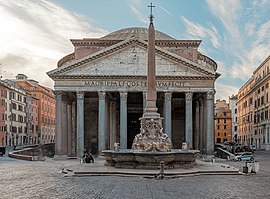 Facade of the Pantheon, with the Pantheon obelisk | |
 Click on the map for a fullscreen view | |
| Location | Regio IX Circus Flaminius |
|---|---|
| Coordinates | 41°53′55″N 12°28′36″E / 41.8986°N 12.4768°E |
| Type | Roman temple |
| History | |
| Builder | Trajan, Hadrian |
| Founded | 113–125 AD (current building) |
The Pantheon (UK: /ˈpænθiən/, US: /-ɒn/;[1] Latin: Pantheum,[nb 1] from Ancient Greek Πάνθειον (Pantheion) '[temple] of all the gods') is a former Roman temple and, since AD 609, a Catholic church (Italian: Basilica Santa Maria ad Martyres or Basilica of St. Mary and the Martyrs) in Rome, Italy. It was built on the site of an earlier temple commissioned by Marcus Vipsanius Agrippa during the reign of Augustus (27 BC – AD 14); then, after the original burnt down, the present building was ordered by the emperor Hadrian and probably dedicated c. AD 126. Its date of construction is uncertain, because Hadrian chose not to inscribe the new temple but rather to retain the inscription of Agrippa's older temple.[2]
The building is round in plan, except for the portico with large granite Corinthian columns (eight in the first rank and two groups of four behind) under a pediment. A rectangular vestibule links the porch to the rotunda, which is under a coffered concrete dome, with a central opening (oculus) to the sky. Almost two thousand years after it was built, the Pantheon's dome is still the world's largest unreinforced concrete dome.[3] The height to the oculus and the diameter of the interior circle are the same, 43 metres (142 ft).[4]
It is one of the best-preserved of all Ancient Roman buildings, in large part because it has been in continuous use throughout its history. Since the 7th century, it has been a church dedicated to St. Mary and the Martyrs (Latin: Sancta Maria ad Martyres), known as "Santa Maria Rotonda".[5] The square in front of the Pantheon is called Piazza della Rotonda. The Pantheon is a state property, managed by Italy's Ministry of Cultural Heritage and Activities and Tourism through the Polo Museale del Lazio. In 2013, it was visited by over six million people.
The Pantheon's large circular domed cella, with a conventional temple portico front, was unique in Roman architecture. Nevertheless, it became a standard exemplar when classical styles were revived, and has been copied many times by later architects.[6]
- ^ "Pantheon". Oxford English Dictionary. Oxford, England: Oxford University Press. December 2008.
- ^ MacDonald 1976, pp. 12–13
- ^ Moore, David (1999). "The Pantheon". romanconcrete.com. Retrieved 26 September 2011.
- ^ Rasch 1985, p. 119
- ^ MacDonald 1976, p. 18
- ^ Summerson (1980), 38–39, 38 quoted
Cite error: There are <ref group=nb> tags on this page, but the references will not show without a {{reflist|group=nb}} template (see the help page).
